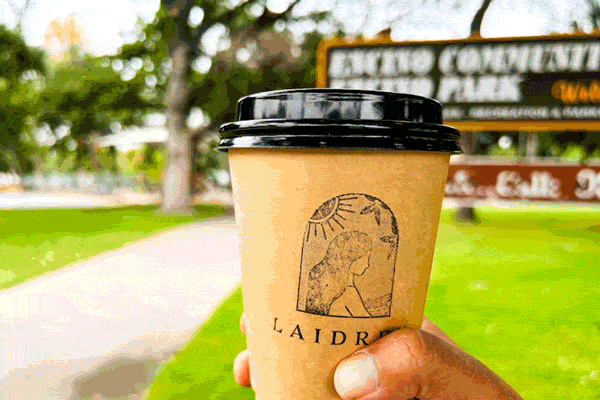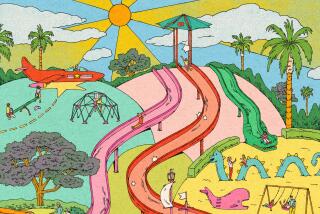Barn Raising Shifts to the Playground : Life Style: With funding scarce, volunteers are getting out their tools and building community projects themselves.
- Share via
NEEDHAM, Mass. — At 7 a.m., the first arrivals begin tramping across dew-laden Greene’s Field toward the volunteer registration tent.
Some confidently wear tool belts and carpenters’ aprons; others come somewhat sheepishly equipped with no more than two willing hands. All are forgoing their regular Saturday morning routines to help convert a prized green space near the center of this west-of-Boston suburb into a sprawling, wooden playground that is sure to fill children’s eyes with wonder.
By mid-morning, what had begun as a trickle turns into a human anthill swarming with 350 people. They check out a trailer full of borrowed power and hand tools, grab cans and cartons of screws and soap-covered spiral nails, and scatter themselves over the job site.
Armband-wearing “skilled” volunteers (anybody comfortable using a circular saw) are placed in charge of small teams, which take their marching orders from two question-besieged supervisors, who represent the architect and carry sheets of detailed diagrams.
Barn raising may have gone the way of horse-drawn plows, but clearly the spirit of joint effort used to erect barns is still alive and well. Here and in a large number of other towns and cities across the United States, neighbors are breaking a sweat together for the sake of their children and their own desire to enjoy group dynamics.
During a bag lunch catered by a nearby hotel, members of Greene’s Field Improvement Committee lounge on the grass and bubble over with the day’s excitement.
Sally Dempsey, a general coordinator who has spent more than a year preparing for the five-day construct-a-thon, calls the project “the ultimate affirmation” of civic values and participation. “When you share a common experience like this, it puts your relationship on a different threshold. It establishes a camaraderie that goes beyond just a smile in the grocery store.”
The esprit de corps that wells up around playground projects is catching. A Californian visiting his in-laws volunteered to work on the Needham playground, and in Stowe, Vt., where another of these labyrinthine structures just went up, tourists pitched in.
“You have to have plenty of shovel-leaners,” said Anne Lusk, a veteran civic leader and coordinator of the Stowe project.
Experience has taught her the difficulties of getting people to roll up their sleeves. “I can pull people together to attend parties and other fund-raising events, but I usually can’t get them together to pound a nail,” she said. Such reluctance, however, never materialized this time as volunteer nail-pounders showed up in force.
“And the beauty of this kind of effort is that the lawyer is equal to the carpenter,” she said of the statusless work environment. “Nobody can pull rank. The caste system you sometimes have in a small town is eliminated.”
Opposition that might hold up or squelch other civic projects is often less daunting too. Who, after all, wants to stand in the way of a children’s playground, especially one built without tax dollars? In Needham, concerns about parking and the size of the structure were readily resolved.
Robert Leathers, whose Ithaca, N. Y., architectural firm has designed more than 400 playgrounds--including the ones in Needham and Stowe--says nothing rallies community spirit as effectively as a playground.
“We helped organize a community theater project once, but it didn’t work out that well. It didn’t have the kids as the nucleus for family support,” he said.
Leathers does 80% of his business in the suburbs or rural areas. The rest is done in cities, where construction of one of his New York creations was featured on Sesame Street. The urban population is no less supportive, just less predictable.
“At some of the city projects, nobody shows up until 2 in the afternoon,” Leathers said. “But they stay until 2 the next morning.”
Leathers is viewed as a Johnny Appleseed figure in the grass-roots playground movement, a keen marketer who knows how to galvanize citizen support. A large part of his success, which he will take to Australia in December, centers on getting the community involved not just in the building and fund raising but also in designing.
Architects from the firm sat down with children from four Needham elementary schools to learn what they’d like in the town’s new playground. The “Design Day” is a staple of the Leathers program, a brainstorming session in which young daydreams supposedly take precedence over adult visions.
“We did a playground in Montauk, Long Island, which is surrounded by boats,” Leathers recalled. “The adults wanted a huge boat as the centerpiece. Not one kid wanted a boat, though. We put a boat into the design, but the biggest motif is a spaceship.”
Just how responsive the Leathers people are to a specific group of children is the subject of debate since some observers, including industry rivals, wonder to what degree customizing is really based on the children’s input.
After several hundred playgrounds, ideas may simply be recycled, skeptics believe. One compares the experience to “baking a batch of Betty Crocker brownies. You do it, but it’s not your recipe.”
Using the multilevel, integrated playground approach allows for numerous minor variations--a spaceship here, a dragon there--but the basic themes and overall look remain much the same. There are many ramps, slides, platforms and towers tied together in what loosely resembles a cross between a maze and a whimsical fort.
Many of the general play elements are standard in the industry and could be purchased right out of a manufacturer’s catalogue.
“We could have had a modular, prefab set,” Dempsey said. “But this project wasn’t just a playground, it was a process.”
To the townspeople, it was the exhilarating challenge of bringing a major civic improvement to fruition in a period of widespread government belt-tightening.
With the “Massachusetts Miracle” on the skids, Bay State communities are reluctant to spend money on anything but the necessities.
Phil Garrity, a Needham selectman, said “the chances of (the playground) happening with town funding were zero,” given a $1-million cut in state aid.
That didn’t discourage Needham’s Junior Women’s Club, however, which not only suggested the project to town officials but also took responsibility for raising the money to build it.
If commercially built, the playground might have cost $150,000 or more. Even with a huge savings from volunteer labor, donated materials and borrowed tools, an estimated $70,000 had to be raised for a medium-size layout.
Large chunks of it were made through an auction and a Hard Hat Ball, in which dress was “construction chic” and the main course was a 100-foot-long sub. The rest has come through corporate sponsors and individual donors, whose names and patronage levels ($100, $500 or $1,000) will be inscribed on a “Giving Tree.”
In Rockford, Ill., children raised more than $13,000 to help pay for a design by Leathers that attracted hundreds of users all summer long. They sold Popsicle sticks for $3 apiece in a symbolic “Buy a Board” campaign and collected spare change during a “Pennies From Heaven” drive.
The price tag on these do-it-yourself projects may seem steep, but playgrounds are considerable liabilities in today’s litigious society, and part of what buyers pay for is legal relief.
“Everyone’s become very aware of risk management,” said Steve King, chairman of the board of Landscape Structures, a major manufacturer of playground structures. “Park and recreation directors and school principals are sucking up information on how they can make their playgrounds safe.”
King says the industry has generally moved away from the concept that higher is better, since “the only thing that increases with the height of the play structure is the owner’s liability.”
A main concern with community-constructed playgrounds is the building material, which is most often pine. While economical, it is subject to splintering and warping, which can pop nails loose. Leathers specifies that customers use a certain type of southern yellow pine. He also requires a final on-site inspection, which includes checking for sharp, unsanded edges.
Attention to this latter detail is where masses of amateurs come in handy, including the young children who were enlisted to sand lumber in Needham. With hundreds of volunteers, Leathers claims that it’s possible to do the mundane, labor-intensive tasks that a professional crew might slight.
The catch is that the volunteer enthusiasm is often short-lived. “Communities love start-ups, but they don’t want to maintain things,” Lusk said.
As part of the architect’s master plan, Needham’s playground committee has established a $10,000 trust fund, the interest from which will pay for periodic maintenance by the Public Works Department.
Long after the playground’s completion, however, the pride of citizen ownership is expected to act as a deterrent to vandalism and neglect. Hundreds of people had a stake in the project, from the child-care workers to volunteer bakers to the ditch diggers, and many are expected to feel the same sort of vested interest as the amateur carpenter who returned for second shift.
“I want to finish my slide,” she announced. The barn-raising beat, it appears, has simply shifted from the barnyards to the playgrounds of America.
More to Read
Sign up for The Wild
We’ll help you find the best places to hike, bike and run, as well as the perfect silent spots for meditation and yoga.
You may occasionally receive promotional content from the Los Angeles Times.






